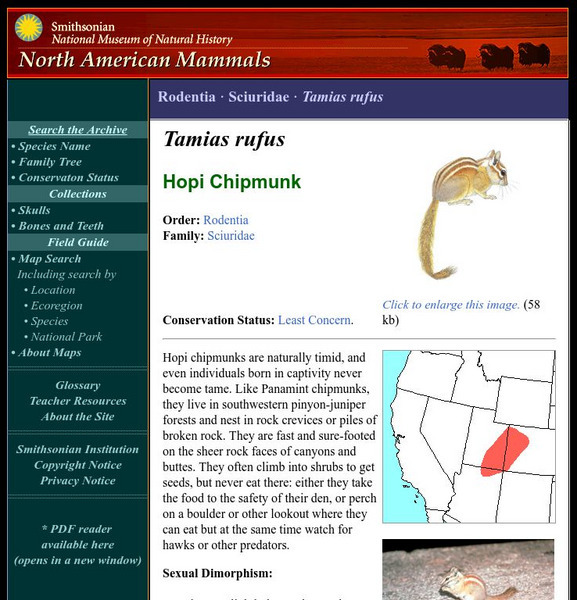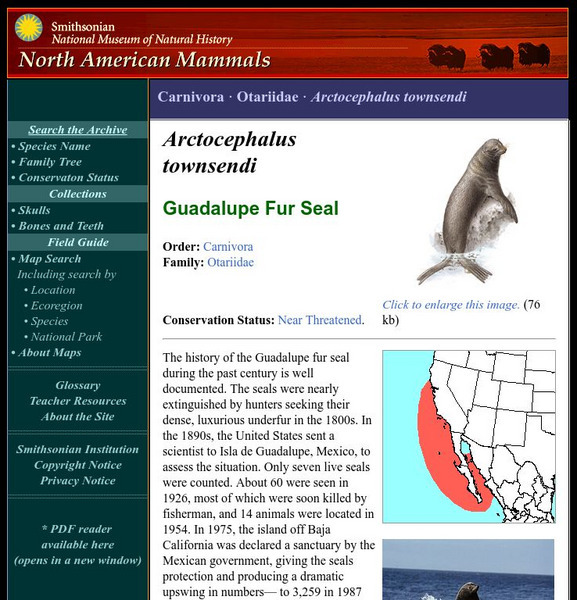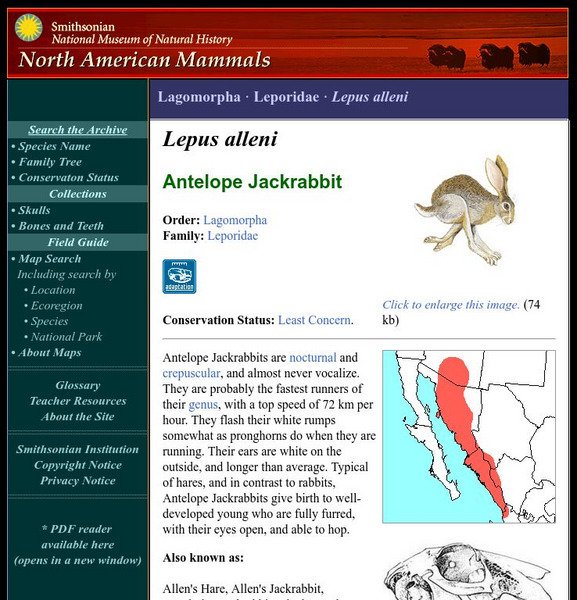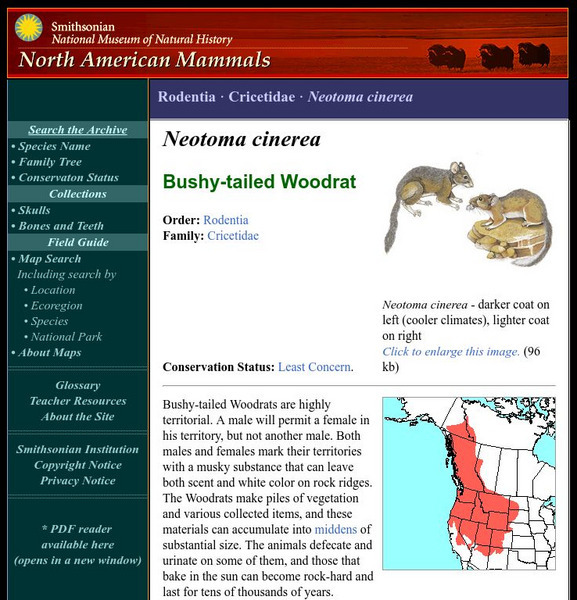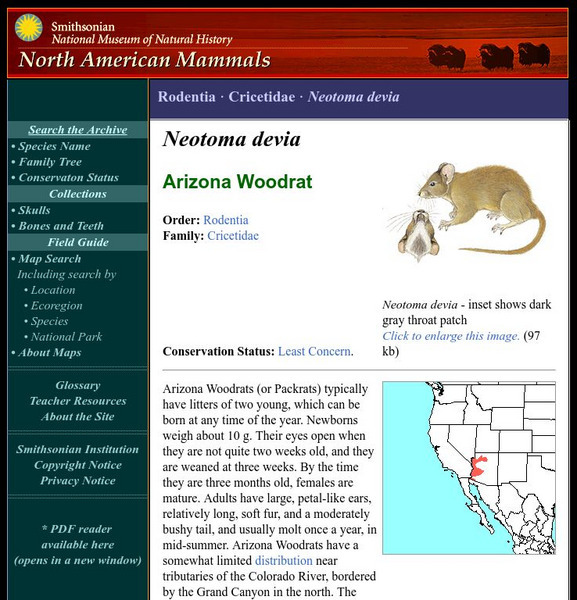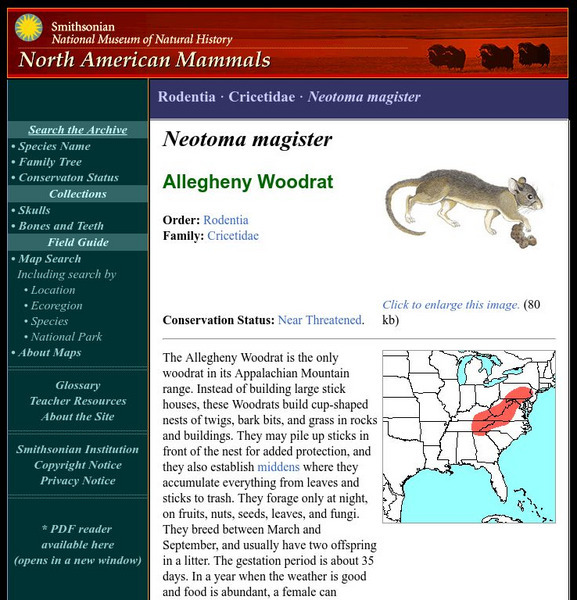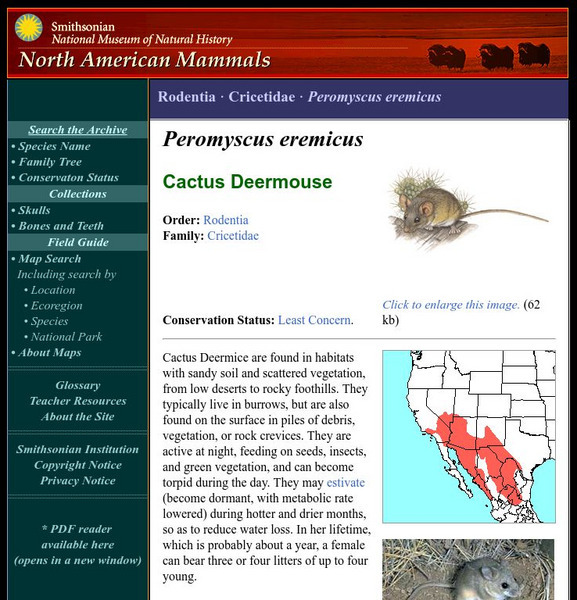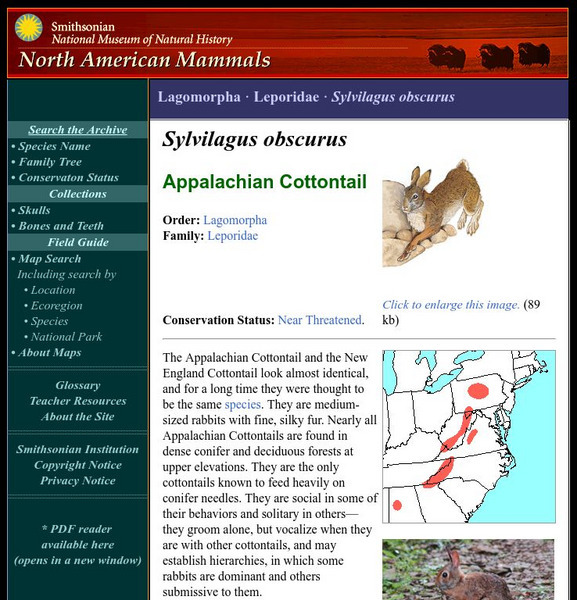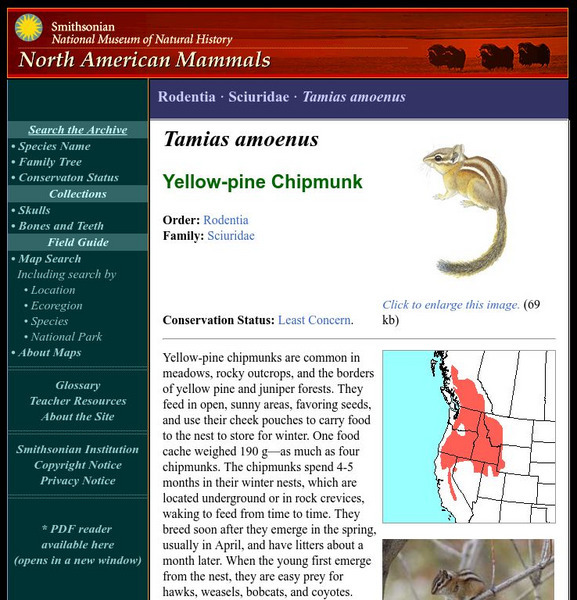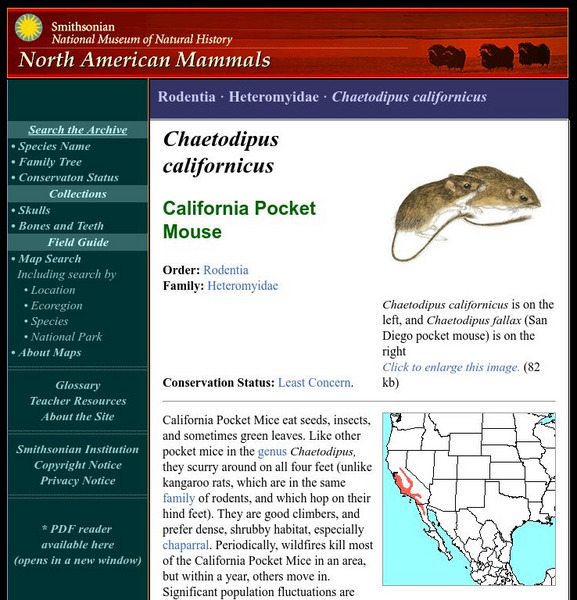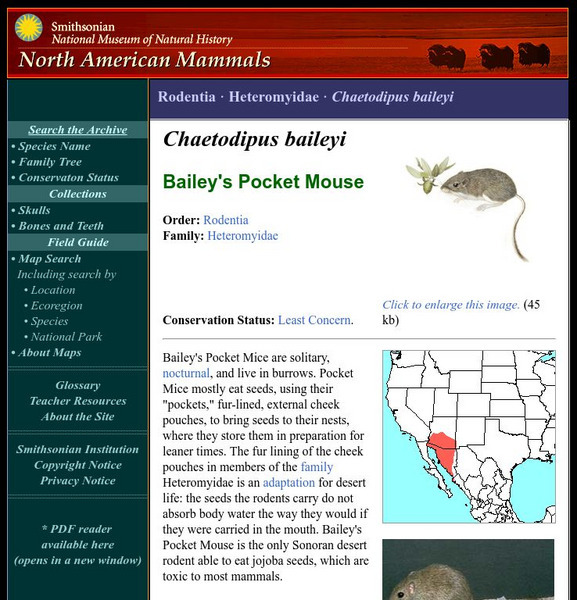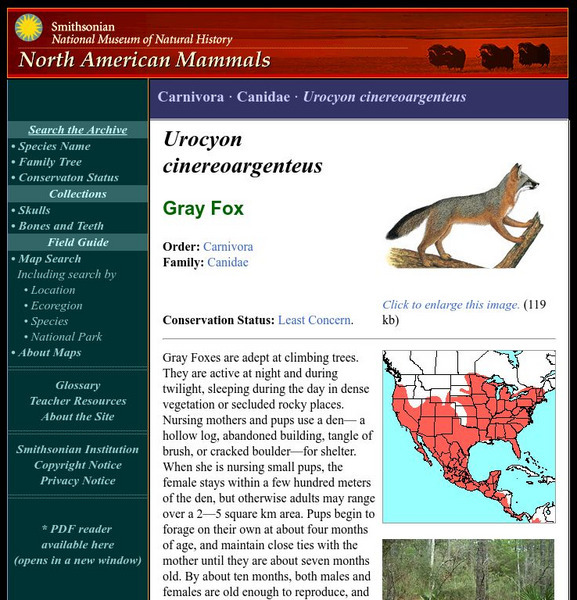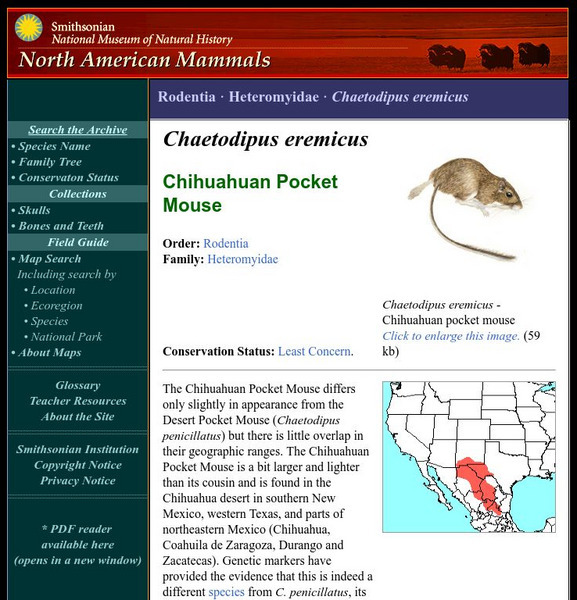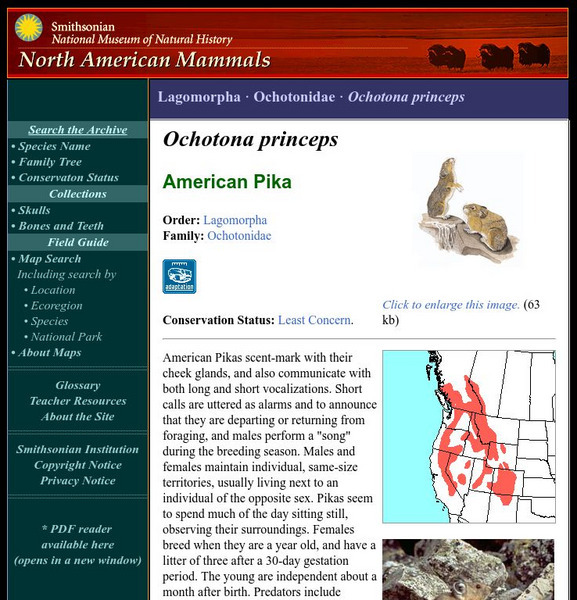Curated OER
A View on Cities: Budapest: Museum of Natural History
Museum of Natural History (Budapest)
Smithsonian Institution
National Museum of Natural History: American Mammals: Preble's Shrew
Very little is known about the natural history of Preble's Shrew, which has been found in widely separate localities in much of the western United States. Specimens have been collected at elevations of 1,280 m in Oregon and 2,750 m in...
Smithsonian Institution
National Museum of Natural History: American Mammals: American Mink
The American Mink, with its luxurious brown coat, is now bred on farms, or mink ranches, to provide fur to the clothing industry. This has relieved some of the stress natural populations endured from trapping over the past two centuries....
Smithsonian Institution
National Museum of Natural History: American Mammals: Western Gray Squirrel
Although Western Gray Squirrels are diurnal, they are secretive by nature and stay away from humans as much as possible. However, they are comparatively frequently hit by automobiles, perhaps because they lack experience of human...
Smithsonian Institution
National Museum of Natural History: American Mammals: Hopi Chipmunk
Hopi chipmunks are naturally timid, and even individuals born in captivity never become tame. Like Panamint chipmunks, they live in southwestern pinyon-juniper forests and nest in rock crevices or piles of broken rock. Learn more about...
Smithsonian Institution
National Museum of Natural History: American Mammals: Townsend's Pocket Gopher
Townsend's Pocket Gophers require deep, moist soils of river valleys and ancient lake beds. Other pocket gophers that are found in the same region, in the northern Great Basin, prefer different soil types: Botta's Pocket Gopher is...
Smithsonian Institution
National Museum of Natural History: American Mammals: Guadalupe Fur Seal
The history of the Guadalupe fur seal during the past century is well documented. The seals were nearly extinguished by hunters seeking their dense, luxurious underfur in the 1800s. Learn more about the Arctocephalus townsendi, more...
Smithsonian Institution
National Museum of Natural History: American Mammals: Antelope Jackrabbit
Antelope Jackrabbits are nocturnal and crepuscular, and almost never vocalize. They are probably the fastest runners of their genus, with a top speed of 72 km per hour. Learn more about the Lepus alleni, more commonly known as an...
Smithsonian Institution
National Museum of Natural History: American Mammals: Black Tailed Jackrabbit
Black-tailed Jackrabbits are tremendous leapers, able to jump more than 6 m horizontally. They live in some of the hottest and driest regions of the continent, can survive on poor-quality foods, and get most or all of the water they need...
Smithsonian Institution
National Museum of Natural History: American Mammals: Bushy Tailed Woodrat
Bushy-tailed Woodrats are highly territorial. A male will permit a female in his territory, but not another male. Learn more about the Neotoma cinerea, more commonly known as a Bushy-tailed Woodrat, in this easy-to-read species overview...
Smithsonian Institution
National Museum of Natural History: American Mammals: Arizona Woodrat
Arizona Woodrats (or Packrats) typically have litters of two young, which can be born at any time of the year. Newborns weigh about 10 g. Learn more about the Neotoma devia, more commonly known as an Arizona Woodrat, in this easy-to-read...
Smithsonian Institution
National Museum of Natural History: American Mammals: Allegheny Woodrat
The Allegheny Woodrat is the only woodrat in its Appalachian Mountain range. Instead of building large stick houses, these Woodrats build cup-shaped nests of twigs, bark bits, and grass in rocks and buildings. Learn more about the...
Smithsonian Institution
National Museum of Natural History: American Mammals: Arizona Pocket Mouse
Like other heteromyid rodents, Arizona Pocket Mice are solitary creatures. They spend the day in underground burrows, emerging only at night. Learn more about the Perognathus amplus, more commonly known as an Arizona Pocket Mouse, in...
Smithsonian Institution
National Museum of Natural History: American Mammals: Brush Deermouse
Brush Deermice occupy rocky and brushy or forested environments in which rock ledges, piles of brush, fallen trees, and boulders offer shelter and denning sites. Although they are reportedly good climbers, they only occasionally build...
Smithsonian Institution
National Museum of Natural History: American Mammals: Cactus Deermouse
Cactus Deermice are found in habitats with sandy soil and scattered vegetation, from low deserts to rocky foothills. They typically live in burrows but are also found on the surface in piles of debris, vegetation, or rock crevices. Learn...
Smithsonian Institution
National Museum of Natural History: American Mammals: Cotton Deermouse
A medium-sized rodent with large ears and eyes, the Cotton Deermouse is dark golden-brown above with white underparts and feet. It is very similar to the white-footed Mouse, with which it breeds in captivity. Learn more about the...
Smithsonian Institution
National Museum of Natural History: American Mammals: Appalachian Cottontail
The Appalachian Cottontail and the New England Cottontail look almost identical, and for a long time they were thought to be the same species. They are medium-sized rabbits with fine, silky fur. Learn more about the Sylvilagus obscurus,...
Smithsonian Institution
National Museum of Natural History: American Mammals: Yellow Pine Chipmunk
Yellow-pine chipmunks are common in meadows, rocky outcrops, and the borders of yellow pine and juniper forests. They feed in open, sunny areas, favoring seeds, and use their cheek pouches to carry food to the nest to store for winter....
Smithsonian Institution
National Museum of Natural History: American Mammals: California Pocket Mouse
California Pocket Mice eat seeds, insects, and sometimes green leaves. Like other pocket mice in the genus Chaetodipus, they scurry around on all four feet (unlike kangaroo rats, which are in the same family of rodents, and which hop on...
Smithsonian Institution
National Museum of Natural History: American Mammals: Bailey's Pocket Mouse
Bailey's Pocket Mice are solitary, nocturnal, and live in burrows. Pocket Mice mostly eat seeds, using their "pockets," fur-lined, external cheek pouches, to bring seeds to their nests, where they store them in preparation for leaner...
Smithsonian Institution
National Museum of Natural History: American Mammals: Common Gray Fox
Gray foxes are adept at climbing trees. They are active at night and during twilight, sleeping during the day in dense vegetation or secluded rocky places. Learn more about the Urocyon cinereoargenteus, more commonly known as a Common...
Smithsonian Institution
National Museum of Natural History: American Mammals: Chihuahuan Pocket Mouse
The Chihuahuan Pocket Mouse differs only slightly in appearance from the Desert Pocket Mouse (Chaetodipus penicillatus) but there is little overlap in their geographic ranges. The Chihuahuan Pocket Mouse is a bit larger and lighter than...
Smithsonian Institution
National Museum of Natural History: American Mammals: Bobcat
The Bobcat is the most widely distributed native cat in North America. Bobcats occupy many habitat types, from desert to swamp to mountains. Learn more about the Lynx rufus, more commonly known as a Bobcat, in this easy-to-read species...
Smithsonian Institution
National Museum of Natural History: American Mammals: American Pika
American Pikas scent-mark with their cheek glands, and also communicate with both long and short vocalizations. Short calls are uttered as alarms and to announce that they are departing or returning from foraging, and males perform a...






